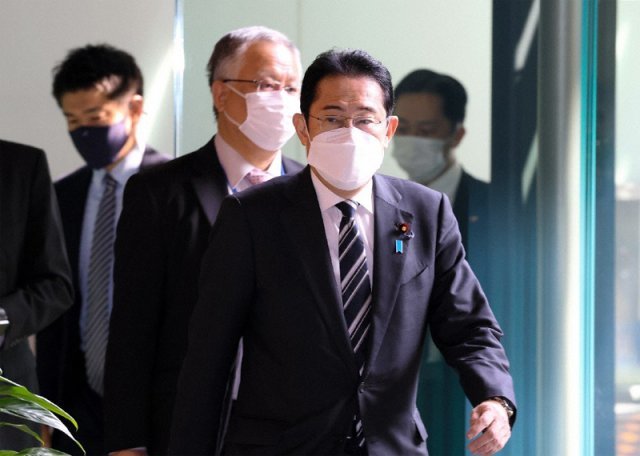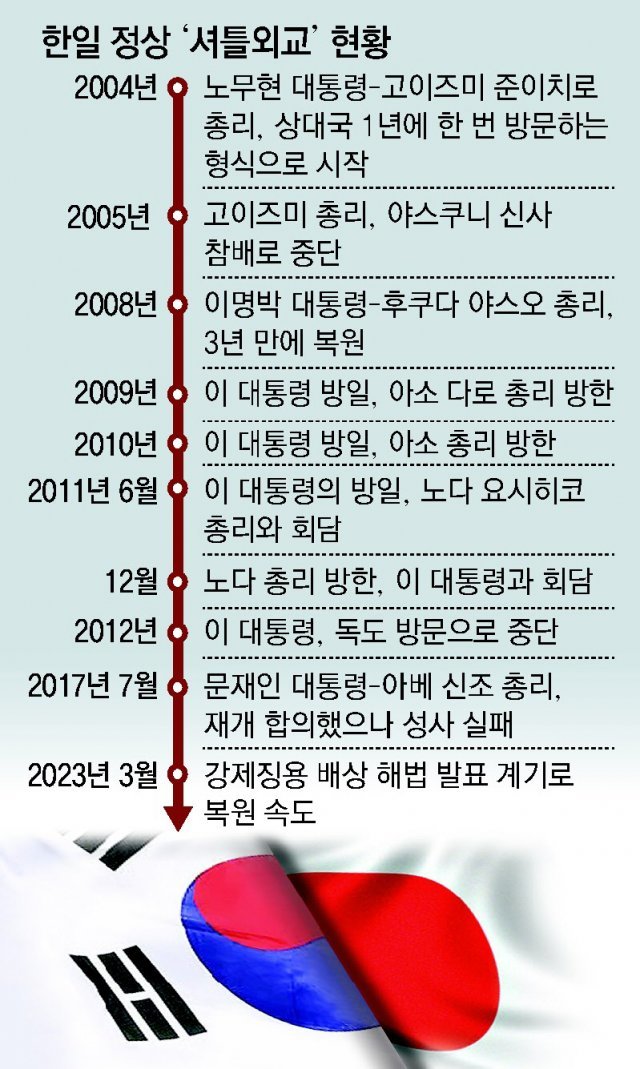I visited Japan on the 16th and 17th… Talk with Kishida
Korea-Japan summit shuttle diplomacy suspended for 12 years
The pace of improvement in Korea-Japan relations, such as the draft resolution
President Yoon Seok-yeol will visit Japan on the 16th for two days and one night and hold a summit meeting with Japanese Prime Minister Fumio Kishida. Beginning with President Yoon’s visit to Japan, ‘shuttle diplomacy’ between Korea and Japan (regular summit meetings going back and forth between the two countries), which has been suspended for 12 years, is scheduled to resume in earnest. The restoration of shuttle diplomacy, which will serve as a symbol of improved Korea-Japan relations, is accelerating, with Prime Minister Kishida coordinating plans for a return visit to Korea in the second half of this year at the earliest.
The Office of the President announced on the 9th that President Yoon would visit Japan on the 16th and 17th at the invitation of the Japanese government. The Japanese Foreign Ministry also officially announced on the same day that President Yoon and his wife, First Lady Kim Kun-hee, would visit Japan in the form of a working visit to hold talks and dinner with Prime Minister Kishida. It is President Yoon’s first visit to Japan after taking office, and it is the first time for a Korean president in about four years since then-President Moon Jae-in visited Osaka to attend the G20 summit in June 2019.
The Office of the President said, “President Yoon’s visit will resume bilateral summit exchanges between Korea and Japan, which had been suspended for 12 years,” and “this will be an important milestone in the improvement and development of Korea-Japan relations.”
It is known that the two governments are discussing to quickly restore shuttle diplomacy. The Yomiuri Shimbun reported on the same day that “Korea and Japan have entered into coordination in the direction of confirming the resumption of shuttle diplomacy at this summit.” He added that Prime Minister Kishida, citing multiple officials, would make adjustments for his first visit to Korea as a return visit after the summit. A high-ranking government official said, “There has been no discussion between the two countries (about Prime Minister Kishida’s visit to Korea), but it is a natural flow to visit Japan for this summit and then visit Korea next time.”
Shuttle diplomacy between the leaders of Korea and Japan began in 2004 with then-President Roh Moo-hyun and Japanese Prime Minister Junichiro Koizumi visiting each other once a year. However, in December 2011, then President Lee Myung-bak’s visit to Japan and talks were cut off for the last time when Yoshihiko Noda was Prime Minister. If Prime Minister Kishida returns, shuttle diplomacy will be revived after 12 years.
President 尹 visits Japan on the 16th and 17th
Kishida, a series of contacts with Japanese conservative heavyweights
Actions to create favorable public opinion in Korea
Japanese media “confirming the importance of GSOMIA”
Policies to Discuss Security-Economic Cooperation at the Summit
 Japanese Prime Minister Fumio Kishida moves inside the Prime Minister’s residence in Tokyo on the 9th. On that day, the Office of the President and the Japanese government announced that President Seok-Yeol Yoon would visit Japan on the 16th and 17th and hold talks with Prime Minister Kishida. Provided by the Asahi Shimbun
Japanese Prime Minister Fumio Kishida moves inside the Prime Minister’s residence in Tokyo on the 9th. On that day, the Office of the President and the Japanese government announced that President Seok-Yeol Yoon would visit Japan on the 16th and 17th and hold talks with Prime Minister Kishida. Provided by the Asahi ShimbunThe governments of Korea and Japan expect that shuttle diplomacy will be restored naturally through this summit between President Yoon Seok-yeol and Japanese Prime Minister Fumio Kishida. This means that the resolution of the tangled threads in the bilateral relationship can be accelerated as it has come up with a difficult solution to the issue of compensation for victims of forced labor during the Japanese colonial period, which was the biggest stumbling block in Korea-Japan relations. The Japanese government is also showing an attitude that it will not miss the trend of recovering relations with Korea, which is said to be the ‘worst since diplomatic ties’.

If shuttle diplomacy is restored, there is a high possibility that Prime Minister Kishida will return to Korea in the second half of this year after the G7 summit to be held in Hiroshima, Japan from May 19 to 21. Until 2011, before shuttle diplomacy was suspended, the leaders of the two countries visited each other once a year for talks.
Prime Minister Kishida said at a doorstepping (summary press conference) on the 9th that he would like to use the summit between Korea and Japan as an opportunity to strengthen bilateral relations.
Prime Minister Kishida has recently been expanding his contact with influential figures in Japan’s conservative society. Analysts say that he is trying to change the atmosphere that is unfriendly to Korea by persuading the Japanese mainstream society, which is very cautious about change and is particularly sensitive to Korea-Japan relations. This is because it is difficult for Prime Minister Kishida, who is a moderate member of the Liberal Democratic Party, to improve Korea-Japan relations, which is also important for Japan’s national security, in reality, unless he is considerate of the mainstream conservatives who have taken a tough stance toward Korea.
On the 8th, Prime Minister Kishida visited the Yomiuri Shimbun, Japan’s largest newspaper, and met with CEO Watanabe Tsuneo (渡邊恒雄). Representative Watanabe is 96 years old this year, but as an elder who symbolizes Japan’s conservatives, he is a person with great influence in the political and business world to the extent that he is called “the shogun (chief) behind the scenes.”
Prime Minister Kishida attended an executive meeting of the ruling Liberal Democratic Party on the 6th, when the Korean government announced a solution to compensation for forced labor, and gave credit to the people around him, saying, “Everyone, including the vice president (Taro Aso), carefully nurtured the atmosphere, and we saw results.” turned On the 9th, Liberal Democratic Party Vice President Aso, who paid a courtesy visit to President Yoon during his visit to Korea in November of last year, said, “I highly appreciate (the Korean government’s solution) as a very big first step toward returning Korea-Japan relations to a healthy level.”
As the first step toward strengthening economic and security cooperation, the South Korean and Japanese governments are also speeding up the lifting of Japan’s export restrictions on South Korea and the normalization of the General Security of Military Information Agreement (GSOMIA).
The Yomiuri Shimbun reported on the 9th, citing a South Korean government official, that “the South Korean government has solidified its policy of normalizing GSOMIA,” and “it is expected that the leaders of the two countries will confirm the importance of GSOMIA at this Korea-Japan summit.” “Finally, (the Korean government) will determine the timing of announcing normalization after seeing the progress in Japan’s lifting of export restrictions on semiconductor materials to South Korea,” he said.
Previously, Japan enforced export restrictions against South Korea in July 2019 as a de facto retaliatory measure against the South Korean Supreme Court’s final ruling on compensation for forced labor, and the Moon Jae-in government sent an official letter to Japan in August of the same year notifying Japan of ending GSOMIA.
Currently, military information is being exchanged according to GSOMIA. However, whenever the Korean government changes, Japan sees it as an unstable state that can be broken at any time, just like the comfort women agreement. Accordingly, it is reported that the Japanese government intends to use this meeting as an opportunity to strengthen security cooperation between Korea, the US and Japan, including normalization of GSOMIA. It is said that North Korea believes that cooperation with South Korea is desperately needed to overcome the serious security crisis that directly threatens Japan’s airspace and nearby seas.
The outlines of President Yoon’s state visit to the United States in April are also being revealed. The presidential office announced that the Korea-US summit will proceed immediately following the official welcome ceremony on April 26. On April 27, a luncheon hosted by Vice President Kamala Harris and Secretary of State Tony Blincoln will be held.
Tokyo =
Source: Donga
Mark Jones is a world traveler and journalist for News Rebeat. With a curious mind and a love of adventure, Mark brings a unique perspective to the latest global events and provides in-depth and thought-provoking coverage of the world at large.